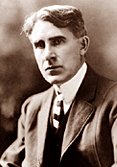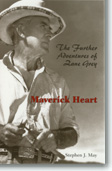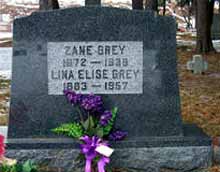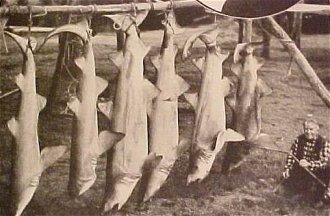ZANE GREY ON THE WEB


MAVERICK HEART
The Further Adventures of Zane Grey
by
STEPHEN J. MAY
Press Release
"Though he is best-known for his Western novels, May suggests that Grey deserves critical recognition as an outstanding interpreter of the outdoors and as something of a proto-environmentalist, instead of being shelved as a minor genre writer. His argument in this regard is entirely convincing, backed with ample quotations from Grey's published writings and unpublished journals. A fine job: May's attentions may well inspire new interest in Grey's largely forgotten work.”—Kirkus ReviewsAthens, Ohio—Stephen May paints a portrait of Zane Grey as an outdoorsman, angler, explorer, ocean voyager, and desert sage in MAVERICK HEART: The Further Adventures of Zane Grey, to be published October 15, 2000, by Ohio University Press. MAVERICK HEART is the companion book to May's acclaimed Zane Grey: Romancing the West (Ohio, 1997) that focused on the crucial period of 1903-1925, when Grey first developed as a writer.
Born in 1872 in Zanesville, Ohio, Zane Grey died in 1939 in Altadena, California. Grey's harsh boyhood may have fueled his ambition, but he became a man who was as complex as his stories were simple. In his many romantic novels he reinvented the world's conception of the West.
Driven, guilt-ridden, and moody, Grey churned out more than five million words in his writing career. Yet his equally amazing adventuring career—fueled by a lifelong love of the outdoors and his flight from depression—has gone largely unremarked. Significant in their own right, Grey's outdoor experiences suffused his fiction.
MAVERICK HEART also gives a nuanced, thorough view of Grey's wife, Dolly, who has long been acknowledged as the force behind the successful novelist. May traces her evolution into a savvy literary agent and businesswoman, as well as an effective editor for a writer who "simply would not edit.” It was Dolly who insisted that Zane Grey travel to the Colorado River Basin, a landscape Grey came to love to the point of worship. He set several novels there, including Riders of the Purple Sage; explorations for his early fiction occurred there, as well as his first magazine articles (epitomized by his account of roping cougars in the Grand Canyon).
His frequent separations from his wife while on hunting trips—as well as his open philandering while on the trail with "secretaries” and "nieces”—drove his marriage to the breaking point. Mayeffectively quotes from Grey's tense correspondence with Dolly regarding his unfaithfulness.
The couple's move from Pennsylvania to California shifted Grey's wandering from the desert West to the sea. In the mid-1920s he began taking longer and more distant trips. Dolly, increasingly confident and independent, became more supportive than resentful—even accepting his affairs as unimportant beside what she possessed, his soul and its genius.
At the peak of his career, Grey bought a 190-foot, three-masted schooner for $17,000—then sank another $40,000 in it for reconditioning. With friends, crew, and his brother R. C., he sailed the Fisherman in 1925 to the Galapagos Islands, Cocos Island, and the Mexican coast. he party collected important whale photographs and film as well as trophy fish and memories of harrowing storms. Grey published his notes of the journey as Tales of Fishing Virgin Seas.
Later, he sailed to the South Pacific, experiencing Tahiti, the Cook Islands, and New Zealand. Grey fell in love with Tahiti and returned there repeatedly; his Tales of Tahitian Waters (1931) is an absorbing narrative of the South Pacific's pioneer anglers and of Grey's love for tropical seas.
Grey later bought a second ship, christened Fisherman II, in which to sail around the world in 1930. Modifications alone cost a staggering $300,000, and the craft proved uncomfortable. Financial strain ended the voyage after six months. In subsequent years Grey returned to freshwater fishing, in the Pacific Northwest.
Even admirers of Grey's westerns admit to his limitations when dealing with human characters. But Grey brilliantly described landscapes and untamed nature, a talent he brought to his nonfiction books and articles. His best outdoor books, in May's view, are Tales of Southern Rivers (1924), Tales of Lonely Trails (1922), and Tales of Fishes (1919).
"If Grey had never written a word about the American West, he still would have ranked among the century's great writers of outdoor nonfiction,” says May.
Despite his expertise and his mania for angling (he set fourteen world fishing records between 1924 and 1936), Grey often depicted himself as a bystander or secondary player. Self-deprecating and ambivalent, he once wrote, "Hunting is magnificent, up to the moment the first shot is fired.”
In addition to Grey's outdoor writings, MAVERICK HEART draws upon Grey's private letters and journals, his important short stories and novelettes, and his novels outside the strictly western romance canon (in particular The Reef Girl and Wilderness Trek).
Grey's tales about his outdoor pursuits show him for the fully rounded writer he became, contends May. "Those critics who dismiss his western novels might reconsider their opinion of Grey as a writer upon the review of his outdoor essays. [They contain] splendid description, insightful narration, frequent humor, surprising vitality, pungent wit, and provocative philosophy.”
Stephen J. May is a literary historian, essayist, and novelist. A resident of Colorado Springs, he has taught writing and American literature at colleges and universities in the western United States.
ZANE GREY MINI BIOGRAPHY Early Life
REF: Zane Grey Museum in Lackawaxen, PA
Pearl Zane Gray was born on January 31, 1872, in Zanesville, Ohio, a town founded by his mother's ancestors. (The spelling of the Gray family name was changed to "Grey" sometime during the late 1890s.) As a youth in Ohio, he developed interests in fishing, baseball and writing. All three pursuits would later bring him acclaim.Grey's baseball prowess led to a scholarship to the University of Pennsylvania's Dental Department. He graduated in 1896 with a degree in dentistry, but chose to play amateur baseball for several seasons, practicing dentistry intermittently. He established his own dental practice in New York City in 1898.
While residing in New York, he continued to play baseball. He loved to get away from the city, and began visiting Lackawaxen, Pennsylvania. There he fished and enjoyed the outdoors as in his youth.
Early Years at Lackawaxen: The Genesis of a Writer
Zane Grey often escaped to Lackawaxen with his brothers. On one of these outings in 1900, Zane ("Doc") met 17-year-old Lina Elise Roth, or "Dolly" as he called her, while canoeing near the Delaware House, a grand boarding house on the river.Dolly was a positive influence in Grey's struggle to become a successful writer. Her encouragement and belief in his abilities led him to continue writing despite rejection by publishers.
Grey's first published article was "A Day on the Delaware," in Recreation magazine, May 1902. In 1903, Grey wrote, illustrated and published his first novel, Betty Zane, with money from Dolly.
The Lackawaxen Years: 1905 - 1918
In 1905, Dolly became Zane's wife. He left dentistry to pursue writing full-time and the couple settled into a farmhouse overlooking the junction of the Lackawaxen and Delaware rivers. In 1906, they took a honeymoon trip to the Grand Canyon in Arizona, and to California — Grey's first trip west.In 1907, Grey met Western conservationist Colonel J. C. "Buffalo" Jones at a meeting of the Campfire Club in New York City. Using the last of his wife's inheritance, Grey accompanied Jones, as a writer and photographer, on a hunting expedition to the Grand Canyon. This trip marked a turning point in Grey's career as it opened up new vistas in subject matter for his writing. He wrote an account of this adventure, The Last of the Plainsmen, published by Outing Press in 1908.
In 1910, Harper & Brothers published The Heritage of the Desert, Zane Grey's first western novel and his first real success. Next came Grey's most noted work, Riders of the Purple Sage, published in 1912. By 1915, Grey had 15 books in print (frontier/baseball/juvenile adventure/ western) along with many fishing and outdoor adventure articles and serialized stories.
Zane and Dolly's three children (Romer, Betty, Loren) were born in New York during the Lackawaxen era. In 1912, the family moved into the house built next door for Zane's brother, R.C. In 1914, Zane and Dolly purchased the house. They enlarged it in 1915 and 1916. Zane's study and office were decorated with a frieze of Navajo sandpainting and Hopi kachina doll designs, painted by Dolly's cousin, Lillian Wilhelm.
Grey continued his travels to the Southwest. He fished in the Pacific off Catalina Island, in the Florida Keys, Mexico and Nova Scotia. He moved his family to California in 1918. The family retained the house in Lackawaxen, visiting when they were on the East Coast. (Zane Grey's last visit was in 1929.)
Later Years
Being in California allowed Grey to work closely with the developing motion picture industry, which had begun producing films based on his novels. For a few years, he had his own production company, Zane Grey Productions, which he sold to Famous Players-Lasky (later Paramount). His new home also provided better access to the Western locations he utilized in his writing.The Greys established a permanent residence in Altadena, California, with a home on Catalina Island and cabins on the Mogollon Rim in Arizona and the Rogue River in Oregon. Grey later had fishing camps in New Zealand, Australia and Tahiti. He reached many sites via his yachts, Fisherman (1924) and Fisherman II (1931).
Zane Grey's influence and success continued through the height of the Great Depression. He was a prolific writer, publishing one or more western novels every year and a fishing or outdoor adventure book every few years until he died. He left behind more than twenty manuscripts which were released after his death.
Grey's success and wealth enabled him to travel the world in pursuit of his favorite sport — fishing. A pioneer in angling, Grey held over ten world records for large game fish. He was the first person to catch a fish over 1,000 pounds on rod and reel (1,040- pound blue marlin in 1930, Tahiti). His last recognized world-record catch, for a
618-pound silver marlin, was not surpassed until 1953.Zane Grey died October 23, 1939, at the age of 67. When Dolly died in 1957, the ashes of both were interred in a cemetery near their home in Lackawaxen, fulfilling their wish to rest together beside the Delaware River.

ZANE GREY STILL WEAVES AN INTERESTING TALE
By HELEN GEORGE
Pocono Record Lifestyle Writer
REF: www.poconorecord.com/
LACKAWAXEN — August Van Osch cringed and eyed the primitive foot-pedal operated dentist drill
in the corner."I wouldn't want that thing working on me," said the 11-year-old from South Orange, N.J.
Van Osch was referring to dental equipment housed in the Zane Grey Museum in Lackawaxen. The
museum was open Saturday during a weekend observation of the prolific writer's birthday on Jan. 31,
1872."We've been here before and we love it," said Cynthia Van Osch, who was with her husband and five
children. "(My children) love the outdoors, adventure, and that he was a great writer, fisherman and he
was involved in the movies. He was a larger-than-life person."Many other visitors were also curious about the author known as the "Father of the Western Novel."
"It's been very busy," said Ingrid Peterec, education specialist with the Upper Delaware Scenic and
Recreational River of the National Park Service. "Seventy people in the first hour and 20 minutes. They
were waiting outside the door at noon."Last year, the museum had almost 6,000 visitors. The museum season runs from weekends in May
through the end of October. Summer hours have not been announced."A lot of people at this time are looking for things to do. They've been in their house all winter," Peterec
said.Zane Grey was extremely popular in his time — it is estimated that he made $37 million in his lifetime
from his writing — but why are people still flocking to his one-time home on the water's edge where the
Delaware and Lackawaxen rivers meet?"They may know Zane Grey and have read his material, but don't know that he lived in this area,"
Peterec said. Grey wrote more than 100 novels and non-fiction books. "Some want to see his home,
where he did his writing, and others are curious and have never read Zane Grey."Ohio Records
Pearl Zane Gray (the family name was changed to Grey in the late 1890s) was born in Zanesville, Ohio.
He was the son of a strict country preacher/ farmer/dentist of Irish descent, Dr. Louis M. Grey.His mother, Josephine Alice Zane, was a descendent of Ebenezer Zane (1747-1812), for whom the
town was named. Ebenezer Zane successfully defended Fort Henry, now Wheeling, W.Va., during the
American Revolution. His sister, Betty Zane, ran ammunition hidden in her skirts. She would figure
prominently in Grey's early writing.In his early teens, Grey penned a short story, "Jim of the Cave," which his father read and disapproved
of. His father wanted one of his three sons to go into dentistry, and he pushed Grey in that direction.Grey, who had interests in fishing and baseball, received a scholarship based on his baseball skills. He
graduated from the University of Pennsylvania in 1896 with a degree in dentistry. After school he played
amateur baseball with the Orange Athletic Club in Orange, N.J., for several seasons, practicing dentistry
intermittently. He established his dental practice in New York City in 1898."Like today, we have people coming from New York and New Jersey, it was the same then. They
came up for vacations and weekends," Peterec said.Grey and his brothers would take the Erie passenger train to Lackawaxen for outdoor activities at a
resort called the Delaware House, which was only a stone's throw away from his eventual home. There
he met 17-year-old Lina Else Roth, known as Dolly."He put his desire and aspirations deep down. It wasn't until Dolly came on the scene and encouraged
him that he wrote," Peterec said.His first published article, "A Day on the Delaware," appeared in Recreation magazine's May 1902
issue.He then wrote "Betty Zane," a work based on his heroic ancestor. No publisher would accept the
manuscript. He self-published the book with money provided by Dolly. She was a teacher who studied
at the Normal School in New York City and Hunter College.This novel is part of the Ohio Trilogy, his first three works based on the American Revolution.
In 1905, Grey gave up dentistry, and he and his now-wife Dolly purchased a farmhouse in
Lackawaxen. His brother Romer built a home, which is now the museum. Another house was owned by
his mother and sister. In 1912, Grey purchased his brother's house and built two additions, used as a
study."It's separate from the rest of the house, so he had peace and quiet," Peterec said. By this time, the
Greys had three children — two of whom are still alive and live in California."It's a very simple and warm two rooms, which makes it conducive to writing," Peterec said.
Grey would write in long hand, in pencil, on yellow legal pads. He wrote in a Morris chair, which
reclines slightly and has wide wood arm rests to place a lapboard on. Often the chair would be put on
the porch for writing.In 1918, Grey's work was to be put on the big screen, and he wanted to oversee the production. He
moved his family out to California, and returned to Lackawaxen occasionally.For a few years, Grey owned a production company, which he sold to Famous Players-Lasky (later
Paramount). The family settled in Altadena, Calif., and had a home on Catalina Island and cabins on the
Mogollon Rim in Arizona and the Rogue River in Oregon. Later he had fishing camps in New Zealand,
Australia and Tahiti.Grey — who is remember for such titles as "The Last of the Plainsmen" (1908), "The Heritage of the
Desert" (1910) and "Riders of the Purple Sage" (1912) — also wrote historical novels and children's
sports stories.He was known as a world-class angler. He held 10 world records for fishing he did in the Florida Keys,
Tahiti, Australia, New Zealand and other locales. Records include catching a striped marlin at 1,040
pounds in 1930, a bluefin tuna, 758 pounds in 1924 and a tiger shark at 1,036 pounds in 1936.Grey died on Oct. 23, 1939. His and Dolly's ashes (she died in 1957) are interred in a cemetery near
their Lackawaxen home.Peterec said that Grey's success was largely based on the tenacity of his wife. "She was the go between
him and the publishers. I don't thing he would have been as successful as a writer hadn't he had Dolly on
his side," Peterec said.Grey probably felt the same way. In a diary entry dated April 23, 1933, Grey writes: "Dolly is ... alert to
all the manifold angles of my work and surely the grandest wife and helpmate any man ever had the
good fortune to possess."Copyright © January 31, 1999, Pocono Record


Back to the Hillman Homepage

BILL & SUE-ON HILLMAN
ECLECTIC STUDIO
Explore Our Other Zane Grey Tribute SitesWe want to hear from you...